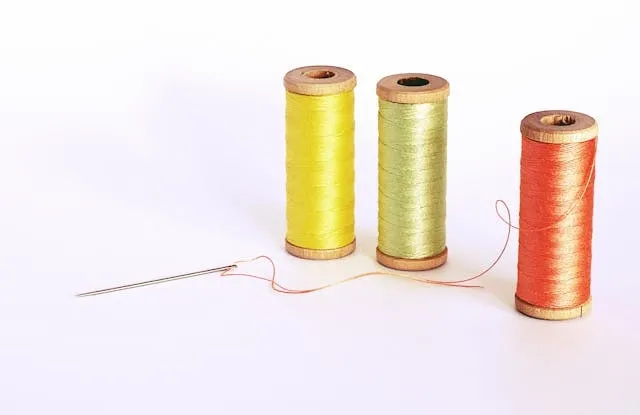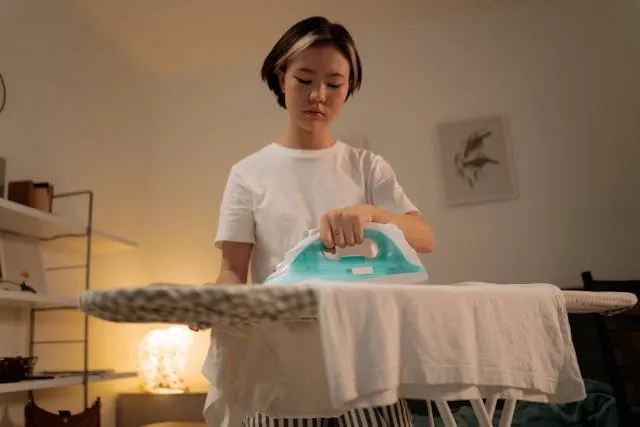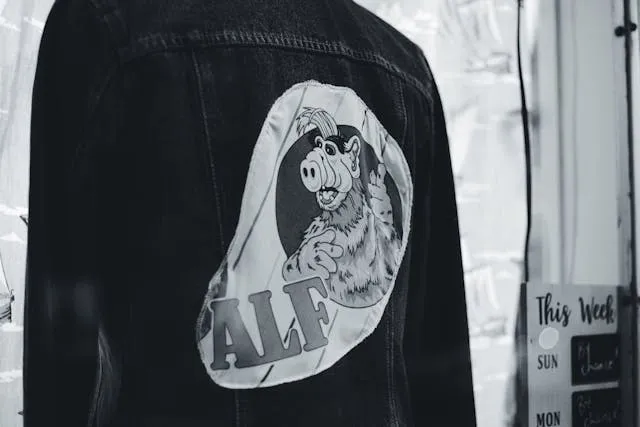Can You Sew Iron On Patches (Stitching Techniques And Best Practices)
Iron-on patches are a convenient and popular way to add embellishments to clothing and accessories. However, there are many who question whether sewing iron-on patches is possible for additional security.
Sewing can help ensure the patch stays in place even after multiple washes. Whether you’re stitching by hand or using a sewing machine, learning how to properly sew iron-on patches can significantly extend their lifespan and enhance their overall appearance.
Read on to learn more.

Key Takeaways
- You can sew iron-on patches to enhance their durability and longevity. It offers added security, particularly on garments that are frequently worn and washed.
- Sewing a patch can enhance its permanence as opposed to simply ironing on. Hand sewing and machine sewing are both effective, depending on the fabric type.
- Delicate or heat-sensitive fabrics can benefit from sewing instead of ironing, and you can use fabric glue to help if a patch starts peeling.
- We supply high-quality iron-on patches that offer a strong adhesion and a personalized design, and you can reinforce their attachment with sewing or other methods.
Table of contents
-
Can You Sew Iron On Patches?
-
How To Sew Iron On Patches For The Best Results
-
How Can Fabric Glue Help If An Iron-On Patch Starts Coming Loose?
-
How To Sew Specific Patch Types Or Materials
-
Can Sewing Help With Heat-Sensitive Fabrics And Patches?
-
Can You Sew Iron-On Patches To Leather Or Denim?
-
Should You Sew Iron-On Patches On Delicate Fabrics?
Can You Sew Iron On Patches?
It is possible to sew iron-on patches. In fact, in some cases, sewing is actually preferable to provide extra durability for your patches. Heat-activated adhesives, like those we use for our custom iron-on patches, are designed to bond with the fabric after being exposed to heat. But sewing them can add security, especially if you are applying to a garment that will be worn and washed frequently.
This approach is particularly useful for heavy-duty items like:
- Jackets
- Uniforms
- Bags
On these items, the iron-on adhesive alone may start to weaken its hold over time. Reinforcing that attachment could be a crucial step to ensuring the patch stands the test of time.
Sewing can also be helpful if a patch starts to peel around the edges, or if your adhesive weakens after multiple washes. Adding some robust stitches around the edge of the patch will guarantee that it stays in place, thus extending its lifespan.

Can Iron On Patches Be Sewn On For Extra Security?
Sewing on iron-on patches will offer extra security for the attachment. The adhesive layer provides a strong initial bond, which will be sufficient by itself in many cases. But if you find your iron-on patch is not sticking, or you want to strengthen its adhesion, you can add some stitches to ensure it stays in place even if the adhesive begins to weaken over time.
This is especially important for high-use garments, such as:
- Denim jackets
- Backpacks
- Uniforms
The frequent movement and washing of these items will potentially weaken an adhesive bond.
Another benefit of sewing around the edges is that it can prevent issues with peeling and fraying. This way, you get a cleaner and more polished look with your iron-on patches. The ironing process alone is certainly quicker, but sewing ensures a more durable attachment, so it is the preferred choice for garments that undergo a lot of wear and tear.
Is It Better To Sew Or Iron On A Patch For Long-Term Use?
If you want to get the most durable attachment for your patches, sewing is usually a better option than ironing alone. When you explore the differences between iron-on vs sew-on patches, you will find that the speed and convenience of iron-on patches are cancelled out by the potential to weaken with frequent washing or exposure to heat. If your garment is worn frequently, adding some stitches to your iron-on patch can deliver the best of both worlds.
By sewing, you ensure the patch stays firmly attached to the fabric. It delivers added durability even after prolonged use. By choosing to combine both, you get the benefit of a strong, consistent bond from the ironing, and the added strength around the edges from sewing.
We would advise that adding some stitches offers better long-term results, particularly for items like jackets, uniforms, and bags. This way, the patch will remain intact and look more professional over time.
How To Sew Iron On Patches For The Best Results
Whether for your jacket, bag, or even a custom t-shirt, you need to use the right technique to sew an iron-on patch for best results. Here’s a rough guide on how to sew iron-on patches successfully:
- Iron the patch in place to secure it, following the patch instructions for optimal adhesion.
- Once the patch cools and the adhesive is set, prepare a needle or sewing machine to stitch around the edges.
- Make sure you choose a thread color that matches the patch or fabric to achieve a seamless look.
- For hand-sewing, a simple straight stitch or whip stitch works best. If you use a sewing machine, set it to add a straight or zigzag stitch to ensure the patch stays in place securely.
- Try to avoid tugging excessively on the fabric as this could cause the patch to shift or make the stitching look uneven.
Follow this process to reinforce the attachment of your iron-on patches.
How Do You Decide On The Stitch Type When Sewing A Patch?
Studies show that stitch type can make a big difference to durability. The density of stitches is particularly important, and things like lockstitch can provide a particularly strong attachment. Choosing the best stitch type for your needs comes down to the fabric and patch material.
- For most applications, a straight stitch is a good option. It provides clean and durable seams and is applicable to simple fabrics like cotton or denim.
- If you are working with a thicker or textured fabric, a zigzag stitch may be more effective, as it offers flexibility and added strength.
- Hand sewers often find that a whip stitch works well. This is where the thread wraps around the edge of the patch and creates a visible border. It is a good choice for patches with intricate designs or delicate edges.
Consider the strength of the fabric when thinking about different stitches. You must also consider the desired aesthetic to get the finish you want.

Want to make a statement with your team's apparel?
Enhance your uniforms with our custom patches!
Order now and create unique uniforms with our high-quality, personalized patches.
How Can Fabric Glue Help If An Iron-On Patch Starts Coming Loose?
It is not uncommon for an iron-on patch to start peeling over time, particularly with heavy use or frequent washing. When this happens, fabric glue can be a useful solution. If your patch begins to lift at the edges, it is straightforward to apply a little adhesive and reaffirm the patch attachment where needed.
You will need to know how to glue patches to fabric to get the best possible results with your glue. Here’s a basic guide to using fabric glue for repairs:
- Apply a small amount of adhesive to the loose areas.
- Press the patch back into place, ensuring even coverage.
- Hold the patch in place until the glue sets fully. You could use a weight or a clamp to do this.
Fabric glue is a quick fix when you don’t have the option to sew or re-iron the patch. But it may not be as permanent as adding some stitches. If your patches endure frequent use, combine fabric glue with a few stitches to ensure maximum security.
How To Sew Specific Patch Types Or Materials
Different patches and materials may require specific sewing techniques for best results. Here are some suggestions for the different types of custom patches we supply:
- Vinyl patches: Select a needle designed for working with thicker materials. You must sew carefully to avoid damaging the patch’s surface.
- Custom embroidered patches: A straight or zigzag stitch works very well, but it depends on the fabric underneath.
- Delicate fabrics: If you are applying to silk or lace, you must take care not to pull or stretch the material. And it’s important to use fine thread and small, delicate stitches.
Our custom patches are designed to be easy to sew. Whether you are working with denim, cotton, polyester, or more intricate fabrics, you will have the flexibility to achieve the perfect design and the optimal attachment. Work with us to get patches that complement the fabric without causing damage.
What To Know When Sewing On Patches By Hand Versus Sewing Machine
The sewing machine was considered the most prominent American mechanical invention of the 19th century, spreading across classes and genders. It was a labor-saving device, and it also delivers strong, consistent stitches for a more robust attachment.
When you sew by hand, you have greater control, which is beneficial for working with delicate fabrics or intricate patch designs. Working by hand, you can be precise with your stitch placement, so it is ideal for patches on uneven surfaces or garments with irregular shapes. But it can be time-consuming and requires a high degree of skill to do a good job.
Sewing machines, meanwhile, provide speed and uniformity. You can use them to attach patches to durable materials like denim or canvas. They are particularly helpful for larger patches, or for attaching multiple patches at once. But it is important to adjust the settings carefully to ensure you don’t damage the fabric.
For the best possible results, choose the method that aligns best with the fabric, patch size, and your level of expertise.
Stand out from the crowd with our unique designs
Customize your style with our patches!
Order now and make a statement
make your custom patchesCan Sewing Help With Heat-Sensitive Fabrics And Patches?
Sewing is a very strong alternative for applying patches to heat-sensitive fabrics. These include materials like:
- Nylon
- Silk
- Leather
These are materials that can be easily damaged by exposure to high temperatures - something that is essential for attaching an iron-on patch.
Sewing can enable you to secure patches to these fabrics without the risk of heat damage. Moreover, some patches are heat-sensitive - these include those will delicate embroidery or embellishments. With these, sewing might also ensure they remain intact without any risk of melting or distortion.
Always use an appropriate needle and thread for the thickness of the fabric. This is important to avoid damage, as is sewing gently to avoid stretching or tearing the materials. Sewing patches onto heat-sensitive fabrics ensures you achieve a strong bond that doesn’t compromise the material’s integrity, but it needs to be done with care.
Can You Sew Iron-On Patches To Leather Or Denim?
It can be more reliable when attaching patches to thick materials like leather or denim to add some stitches rather than relying on ironing alone. Leather, in particular, may not respond well to heat, potentially leading to damage or insufficient adhesion. If you are working with denim, you should learn the precise process for how to iron on patches to jeans to achieve a strong adhesion.
When you sew patches onto leather, make sure you use a strong needle and a durable thread. This will ensure your tools are sufficient to penentrate the touch material without tearing it. Denim, meanwhile, is more heat-resistant, but it will benefit from the added security of stitching, particularly with high-use garments or on high-stress areas like elbows or pockets.
Sewing ensures that the patch stays in place for the longest possible period. This makes it a preferred method for both leather and denim applications, and you can use it in combination with ironin if you want to.
Add a personal touch with our custom patches
Express yourself with our wide range of designs
Order now and make it yours.
Should You Sew Iron-On Patches On Delicate Fabrics?
Ironing patches onto delicate fabrics like silk or lace presents the risk of irreversible damage to the material due to exposure to heat. When you are working with this type of fabric, sewing is a safer option as you can achieve a secure attachment without compromising the material’s intensity.
Hand-sewing works best when working with delicate materials. It allows for careful, precise stitches that will not tear or stretch the fabric. When you sew patches onto delicate garments, we recommend using fine thread and small needles to keep the risk of damage to a minimum. It is also essential to carefully position the patch and secure it in place lightly before sewing. Make sure you don’t pull the fabric tightly as you apply the stitches.
You don’t need to be quite so careful when working with a more robust fabric, like that of a non-woven tote bag. But sewing can still help achieve a more robust adhesion.

How To Safely Sew Iron-On Patches To Delicate Fabrics
To sew iron-on patches to delicate fabrics safely, you should start by pinning the patch in place as this will prevent it from shifting. Make sure you choose a small, sharp needle and a fine thread that is a good match for the color of your patch and fabric.
Carefully sew in small stitches around the perimeter of the patch, taking care not to pull too tightly as this might pucker the fabric. Hand-sewing is the best approach for delicate fabrics as machine stitching may be too harsh and risks tearing the fabric.
Take your time to sew evenly, particularly on materials such as:
- Silk
- Lace
- Chiffon
Your care and patience will be key to preserving the integrity of the fabric. Make sure your patch is a good match for the style of the garment. When you work with us, you can make custom cheap patches that offer high-quality printing and craftsmanship to ensure your patches are the right fit for the fabric in question.
Frequently Asked Questions About Can You Sew Iron On Patches
Can You Sew Iron On Patches, Or Should You Stick To Ironing?
You can sew iron-on patches to enhance their durability, particularly on items that you wear frequently. Ironing provides the initial bond, but sewing adds extra security to make it more suitable for long-term use.
Is It Better To Sew Or Iron On A Patch?
Sewing is generally better in terms of creating a robust, durable bond, but ironing is better for providing a quicker, convenient attachment. On garments that will be worn and washed frequently, sewing provides a more secure solution.